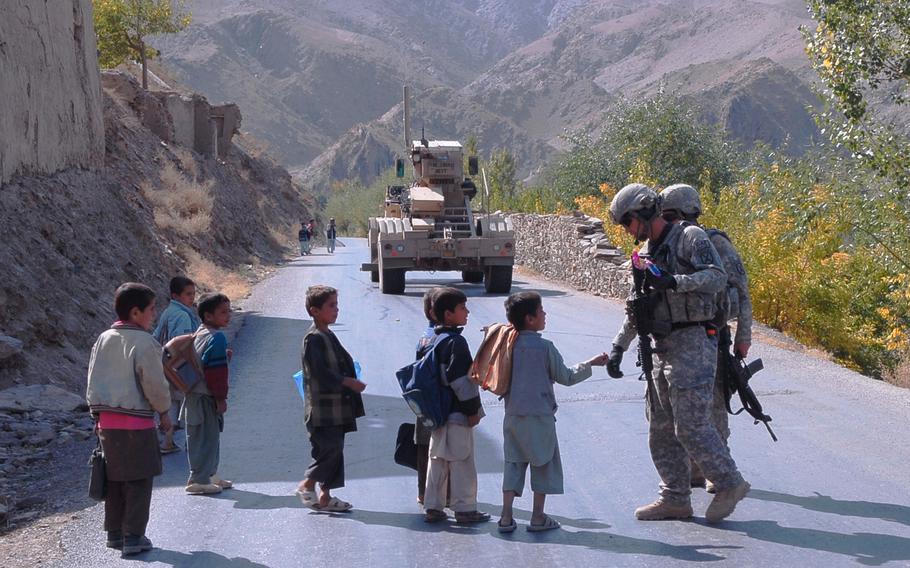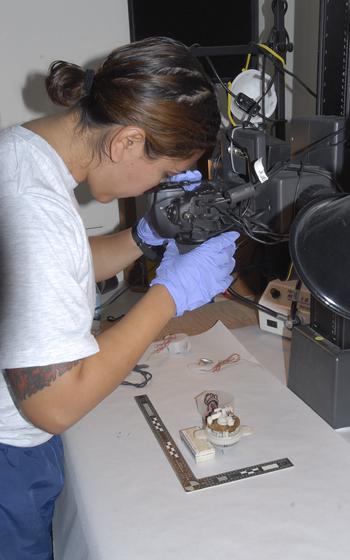
Soldiers give out candy while on patrol through the picturesque Tangi valley in Wardak province on Oct. 17, 2009, in search of bombs. The region is prone to bombs that target their convoys as they move through the hostile yet beautiful valley. (Dianna Cahn/Stars and Stripes)
First of two parts. See part two here.
This article first appeared in the Stars and Stripes editions, Nov. 24, 2009. It is republished unedited in its original form.
Wardak province, Afghanistan — It was hour six on the convoy traveling through the quaint villages and apple orchards of the Tangi Valley and the armored vehicles were just minutes from their destination in the heart of insurgent territory.
Then, suddenly, came the explosion, its sound unmistakable even inside a vacuum-sealed Buffalo vehicle two back in the convoy chain.
“IED! IED! IED!” the radio erupted. The convoy had struck an improvised explosive device.
The bomb technicians and their counter-IED colleagues were already out the doors, running toward an incident that the rest of the world would run from, ignoring the knowledge that one exploding bomb could mean there were more nearby.
For forces on the ground, the IED evokes an almost mythical terror. But for Task Force Paladin, a specialized bomb-hunting unit that is waging war against the IED, the top killer in Afghanistan is simply another weapon they have to defeat.
It is not easy, even with the added manpower, training and focus Paladin devotes to the IED fight. All the hard work is barely enough to keep pace with an enemy fueled by corruption, a duplicitous local population and access to a steady stream of explosives and bomb materials flowing from Pakistan and beyond.
Since 2007, the number of known IEDs placed by insurgents in Afghanistan has more than doubled, climbing from 2,056 from January through October in 2007 to 6,198 by late October this year. Meanwhile, the number of coalition forces killed and wounded has more than tripled, showing that not only have the insurgents increased their bombing activity, they’ve boosted the size and effectiveness of their bombs as well.
Paladin is more than a unit on patrol. It is a team of experts in bomb technology, forensics and intelligence gathering, devising new ways to protect forces, capture bomb makers and keep U.S. troops “left of the boom” — stopping the next bomb before it strikes. By studying IEDs, they work to dismantle the network of bomb makers.
“The devices have personalities, and you see where a lot of devices are related,” said Maj. Bryan Pelley, who runs the Paladin East laboratory, one of two that analyze evidence taken from the site of IEDs in Afghanistan. “It gets you beyond the mythical, all-powerful thing and to the fact that it is created by another human being and it can be defeated.
“That’s not to say [insurgents] are not very smart,” Pelley added a bit grudgingly. “Being able to make functional devices from very primitive materials, sometimes you can’t help be impressed by what they are doing.”
Bomb blasts are frequent
Soldiers in Wardak and elsewhere often speak not of whether they’ve been hit by IEDs but how often. Civilians and the Afghan National Security Forces are even more at risk without protective armor and vehicles.
Along the 20-mile drive into the Tangi Valley on a recent day in October, explosives ordnance disposal team leader Air Force Tech. Sgt. Vandiver Hood, at Forward Operating Base Airborne in Wardak, played IED tour guide. The valley saw 141 bombs from June through September, with more than 40 explosions killing two soldiers and wounding 68.
Hood pointed to a location where three IEDs were found in the last month. A few miles further down, he pointed again.
“This is the IED spot,” said Hood, of the 4th EOD Flight, 4th Civil Engineers Squadron. “We’ve had 15 IEDs here.”
The patrol stopped frequently, allowing the lead Husky vehicle to scan for metal with its ground-penetrating radar and the mine-roller at the front of the second vehicle to slowly press forward, its job is to detonate any pressure-activated bomb ahead of the vehicle. Soldiers walked the apple orchards and onion fields, checking for command wires linking a triggerman to a homemade bomb planted under the road.
As the men who face the bombs daily, EOD technicians are often cool, independent thinkers who joke freely, don’t ruffle easily and approach their jobs with intent focus and confidence. Their commander says that leading them is like “herding cats:” You can’t order them so much as cajole. They can also be superstitious, particularly on their last week of deployment.
It’s like déjà vu
When a triggered device hit the rear end of the mine-roller vehicle, Pfc. John Gudzelak, 23, the driver, and gunner Pfc. Justin Griffin, 19, of the road-clearing patrol, were knocked unconscious. So were an Afghan bicycle rider and a pedestrian. All revived and shakily walked away.
It was Gudzelak’s third IED hit and Griffin’s fourth.
“That’s why I couldn’t get to sleep last night,” Griffin said.
“I had deja vu again today,” Gudzelak said. “It’s always a sign.”
Road-clearing leader Lt. Chris George and another soldier forded a freezing river, following buried command wire across fields and ridges. It took them 45 minutes to unearth all 1,200 yards.
Later, George checked on his rattled men. Griffin wanted a piece of the wire to wrap on the band around his helmet. He put it next to the other three.
At the truck, the EOD technicians and the counter- IED team picked the site clean of any remnants of the bomb or whoever planted it, and they carefully placed each piece of evidence into a separate marked plastic bag.
As the convoy towed the disabled mine roller back to base, residents of a nearby town lined the hillside overlooking the road, watching the wounded American convoy. They looked like they had come out to watch the show.
A game of cat and mouse
Counter-IED efforts are yielding results. U.S. forces have detained dozens of suspects with evidence linking them to bombs. Here in Regional Command-East, Paladin officers point to a decrease in the number of dead compared to wounded, largely due to the use of Mine Resistant Ambush Protected vehicles known as MRAPs, showing that their experience is saving lives.
But coalition forces believe they are still only finding and defusing one bomb for every one that goes off, driving home the disturbing knowledge that every time one side steps up its game, the other side is answering in kind.
First soldiers rode Humvees and insurgents targeted them with radio-controlled bombs. So U.S. engineers created radio jammers.
The insurgents replied by increasing the size of the bombs and switching to vehicle-triggered pressure plates. Paladin answered by putting soldiers in MRAPs with a V-shaped hull to diffuse the blast and brought in the Husky and the mine-roller.
The insurgents then set the bombs back from the plates to outsmart the mine roller. The Americans created variable settings for the mine roller so insurgents would not know how far to offset the bombs.
Now insurgents are using command wires to trigger bombs, and U.S. troops are going back to more dismounted patrols.
“It’s a game of cat and mouse,” said Maj. Mike Slevin, deputy commander of Paladin East, an EOD officer with the Washington National Guard in Tacoma and the city’s assistant director of public works.
“You can’t stop the bombs,” he added. “You have to find the guy that’s making the bombs, the guy that’s financing the bombs. Left of the boom, find a way to use it against him before he puts another bomb in the ground.”
Meanwhile, coalition commanders are increasingly recognizing that the armored vehicles are getting in the way of the ultimate goal of winning public support.
“The enemy is effectively separating us from the population by using the IEDs,” said Lt. Col. Brennan Phillips, the Paladin East commander. “The IED is an equalizer for the enemy against the best military might in the world.”
Collecting evidence back at the lab
At the lab, forensics photographer Staff Sgt. Araceli Alarcon of Waco, Texas, photographed pieces of a washing machine timer used to set off a bomb. It was one of 100 cases the team worked on in a week.
In the next room, lab technicians examined wires, cigarette butts, water bottles — anything that could give them insights into the humans behind the bombs. Electrical analysts studied the wiring, and chemists analyzed soil samples and residue.
Then the intelligence sector compiled and analyzed all the information and data. The goal is to eventually generate enough evidence to get bomb makers off the dirt roads of Afghanistan.
Folks at the lab know that they are fighting an uphill battle. They compile evidence that in a U.S. court would lead to a conviction. But in the tribal provinces of Afghanistan, justice is often described as a program of “catch and release.”
Still, Paladin soldiers and analysts believe they are building the foundation for a day when crimes in Afghanistan are solved and perpetrators are punished according to rules and laws.
“Our job is to buy time and space for the development and the governance-building to work so the Afghan people will hopefully buy into their government,” Slevin said. “If that isn’t built up, the whole thing is for naught.”

Staff Sgt. Araceli Alarcon, a forensic photographer with Joint Task Force Paladin, examines a washing machine timer that was used in a recent bomb device in eastern Afghanistan. Paladin's laboratories, one in the east and one in the south, examine evidence from bomb sites using chemical, biological and physical sciences to compile as much detail as possible on the bomb makers and their techniques. (Dianna Cahn/Stars and Stripes)